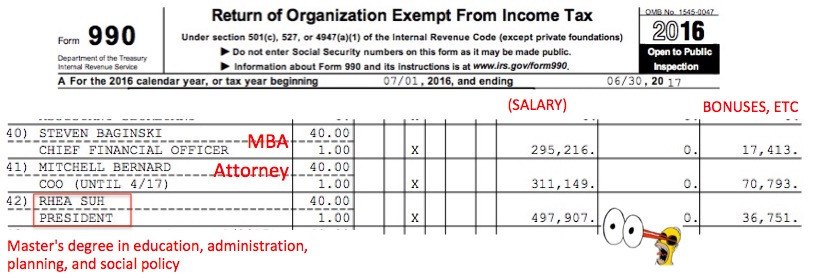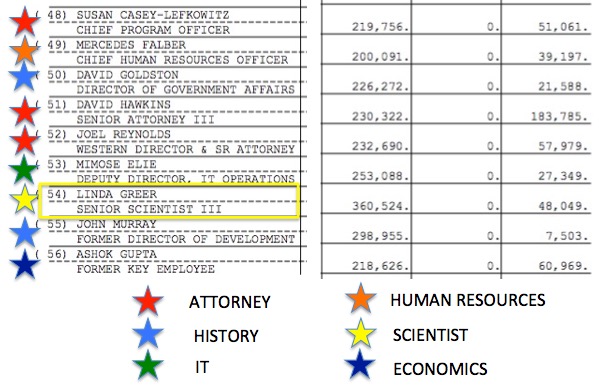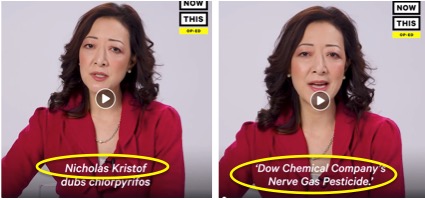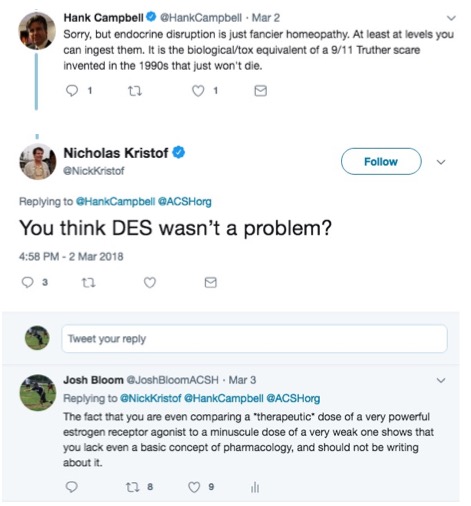It's not often that I have a whole lot of positive things to say about the Natural Resources Defense Council (NRDC). But there's no denying that they can sure make an effective scare video. And even though it's a bunch of BS, it sure is well done.
But for a group that makes a whole lot of money - more than 100-times what ACSH does - you might think that they could afford to find a decent scientist or two somewhere. I mean, their corporate officers sure do well enough...

And so do a bunch of other people...

But what about scientists? Assuming I can read a 990 form (1) correctly, in 2016, the 12 highest paid NRDC employees earned an average of about $330,000. Exactly one of them is a scientist.
So it shouldn't be all that surprising that a video that has been flying around the Internet gets superlative grades for propaganda but not so much so for science. The video, which "stars" NRDC president Rhea Suh is a real piece of work. It is also a fine example of the way NRDC takes partial truths and uses them to scare people. In this case, it's what the video doesn't say that really makes the scare.
In the mood for a trick? You don't have to wait long. Early in the video, we see three frames that imply that EPA Commissioner Scott Pruitt (who is now gone) recently approved chlorpyrifos and now we are being bombarded with a new chemical that also happens to be a nerve gas.

Next, the propaganda kicks into high gear. It's Nazi comparison time!

So, the "new" nerve gas isn't really new after all. It's pretty much the same (Frame 3) as something that was used before. Suh says:
But for a group that makes a whole lot of money - more than 100-times what ACSH does - you might think that they could afford to find a decent scientist or two somewhere. I mean, their corporate officers sure do well enough...

And so do a bunch of other people...

But what about scientists? Assuming I can read a 990 form (1) correctly, in 2016, the 12 highest paid NRDC employees earned an average of about $330,000. Exactly one of them is a scientist.
So it shouldn't be all that surprising that a video that has been flying around the Internet gets superlative grades for propaganda but not so much so for science. The video, which "stars" NRDC president Rhea Suh is a real piece of work. It is also a fine example of the way NRDC takes partial truths and uses them to scare people. In this case, it's what the video doesn't say that really makes the scare.
In the mood for a trick? You don't have to wait long. Early in the video, we see three frames that imply that EPA Commissioner Scott Pruitt (who is now gone) recently approved chlorpyrifos and now we are being bombarded with a new chemical that also happens to be a nerve gas.

"So, today, Dow's nerve gas pesticide is on our food."Today? This is intentionally misleading. Chlorpyrifos has been around since 1965, is currently used on about 50 different crops. Yes, today some of it is on our food, just like the 19,345 days before today.
Rhea Suh
Next, the propaganda kicks into high gear. It's Nazi comparison time!

So, the "new" nerve gas isn't really new after all. It's pretty much the same (Frame 3) as something that was used before. Suh says:
"...chlorpyrifos is adapted from nerve gases made by Nazi Germany during World War II."This phrase "adapted from" will most certainly be interpreted by some (many? most?) viewers to mean that chlorpyrifos is more or less indistinguishable from Sarin, the nerve gas that was used by Nazi Germany. This is a gigantic lie. Although chlorpyrifos, Sarin, and VX (the worst of them) all act by the same mechanism - inhibition of the enzyme acetylcholinesterase in neural synapses - the difference in potency between the chemical weapons and the pesticide is enormous (Table 1). VX, the granddaddy of neurotoxins is about 10-times more toxic than Sarin, but Sarin is hundreds of times more toxic than chlorpyrifos. You cannot compare the two. Sarin is a very good chemical weapon. Chlorpyrifos is not. Equating them is like saying that a pebble and a falling boulder will do equal damage to your car because they are both made of rock. Nice touch tossing Hitler in there too.

And then we get to hear from an "expert."

These two frames above show how desperate NRDC is to make its point. New York Times columnist Nicholas Kristof has no scientific or pharmacological training whatsoever (and it shows), yet he continues to write about toxic chemicals (2). The American Council has perennially challenged his silly statements about toxic chemicals in writing (See Why I Don't Write About Pottery From the Ming Dynasty And Nick Kristoff Shouldn't Write About Science) in a video, and on Twitter, where he recently trumpeted his ignorance in a discussion with ACSH president Hank Campbell and me.

If Nick Kristof is the really the science face of NRDC then these guys badly need a facelift. With a forklift. And guess what? That's just the case. The NRDC doesn't quote a single scientist in its video, just Krystof. You'd think that a non-profit organization that raised $177 million (and had a total of $306 million in assets) in 2016 (Figure 1) might go a little heavier on the science, but I guess they'd rather pay lawyers, history majors, and economists. Perhaps this is why this inane video is so... inane. And why NRDC is far more interested in scaring you than educating you. (3)

Figure 1. Sections of the NRDC 2016 Form 990 showing revenue ($177 million) and net assets ($306 million).
If you think the message I'm sending is that chlorpyrifos is harmless you're wrong. It is not. All pesticides are, by definition, toxic. And even though it has been used for a long time that does not necessarily make it safe. There are plenty of other pesticides (permethrin, for example) out there that are less toxic than chlorpyrifos.
Should it be banned? I don't know. It has significant utility in agriculture but a number of studies of varying quality have shown associations between exposure to the chemical and a negative impact of certain measures of neurological function in children. There are also studies that show otherwise. An article on the FactCheck.org site examines both sides of the story and concludes that there is no easy answer:
Based on the available research, there is evidence to suggest that chlorpyrifos negatively impacts the development of children. But that research does have some limitations, and whether it is sufficient evidence is debatable.That is real science - a look at the risks and benefits of the chemical with a conclusion that it may be harmful and should be banned or that there is not enough evidence to support a ban. Somewhere in there lies the best answer, but it will not be a clear yes or no.
Vanessa Schipani, FactCheck.org, April 27, 2017
Do not expect such candor or nuance from a bunch of overpaid lawyers and history majors. Just propaganda.
NOTES:
(1) From Wikipedia: "Form 990 (officially, the "Return of Organization Exempt From Income Tax") is a United States Internal Revenue Service form that provides the public with financial information about a nonprofit organization. It is often the only source of such information. It is also used by government agencies to prevent organizations from abusing their tax-exempt status."
From the IRS: "All filing organizations ... must list and report compensation paid to the organization’s five highest compensated employees with reportable compensation greater than $100,000 from the organization and related organizations, as well as to its five highest compensated independent contractors to which the organization paid more than $100,000 for services."
(2) One of Kristof's favorite villains, BPA, (he won't touch cash register receipts because they contain a little) was recently declared to be safe by the FDA after an extensive two-year study in rats. (See BPA Is Just As Dangerous As It Never Was.)
(3) It's nothing short of hilarious that groups like NRDC when they can't argue science with us (and it should be pretty obvious why they can't) that they call us "industry-funded" and "fat cats" when they had $177 million tossed at them in 2016 - more than 100-times what we got that year. Corporate funding accounts for only 3% of our donations. We're pretty lean, perhaps because we don't have a bunch of lawyers to pay.
No comments:
Post a Comment